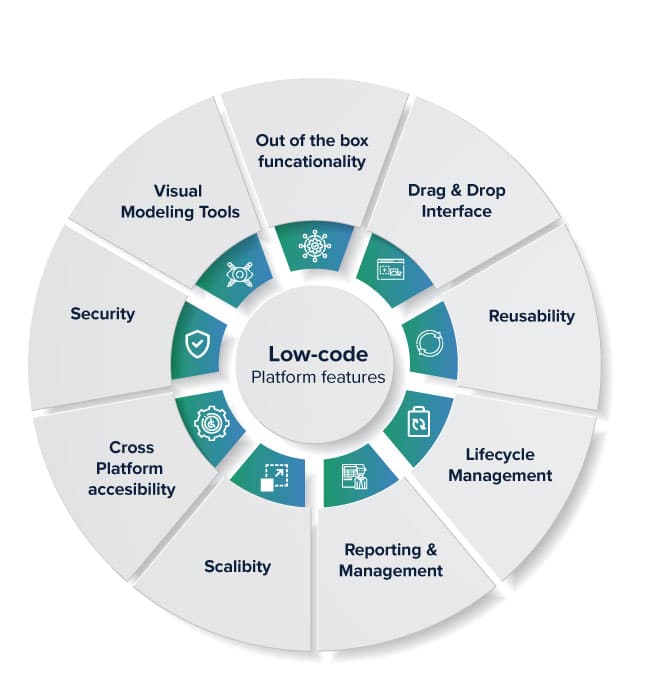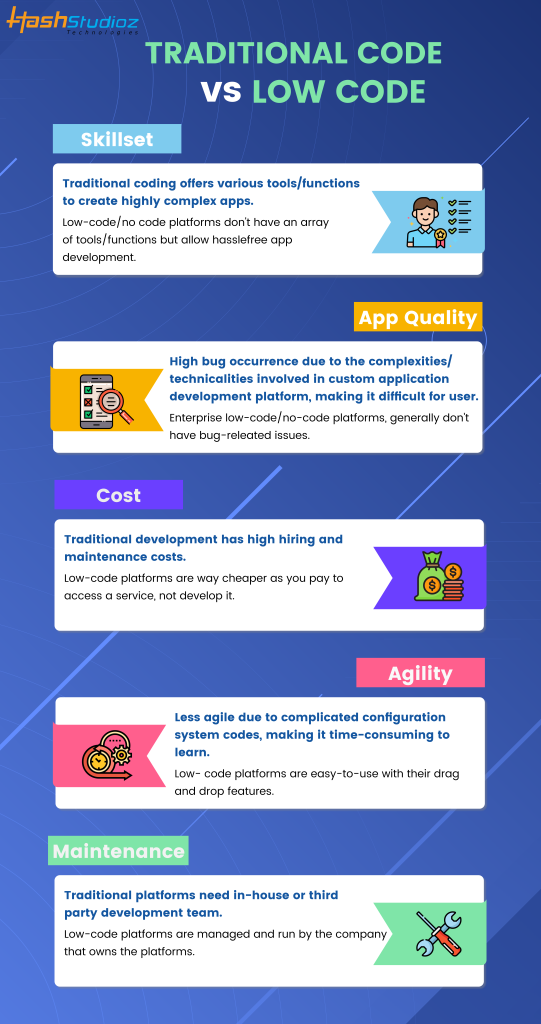Good Ideas For Selecting Legacy application modernization with Low-code
Wiki Article
In Terms Of Integration Capabilities, Low-Code Development Of Applications Has Numerous Advantages.
Low-code application development offers significant advantages in terms of integration capabilities. They are essential for creating applications that seamlessly connect with diverse platforms and services. These are the main advantages: Pre-built connectors and APIs:
Many Connectors Low-code software typically includes the prebuilt connectors for the most popular enterprise applications (e.g. CRMs, databases ERPs, cloud-based services, and more). This makes it easier for integration with these systems.
API Integration: A lot of low-code platforms include out-of the-box integration API capabilities which allow developers to easily connect with external services and sources of data.
Easy of use:
Drag-and–Drop Interfaces: Many integration tasks can easily be accomplished using drag-and-drop interfaces. This makes it possible for developers and other non-developers alike to create complex systems without lengthy programming.
Visual Workflow Creators: The visually appealing tools used to design workflows and data flow make it easier for users to understand the process of integration.
Standardized Integration Methods:
SOAP and RESTful Services : The support for web services standards such as REST and SOAP facilitates easy integration with a variety of external systems.
OData and other Standards The support for standards such as OData allows access and manipulation of data across different platforms and applications.
Real-Time Data Synchronization:
Real-Time Integrations: Low-code platforms are capable of handling the real-time synchronization between data applications, systems as well as databases. This ensures that all data is current and consistent across an company.
Event-Driven Architecture: Certain platforms have support for event-driven architectures, enabling applications to respond to events in real-time. This is essential for interactive and dynamic applications.
Legacy System Integration:
Interconnecting Old Systems and new Systems Low-code platform often provides tools to integrate with existing older systems. This allows organisations to modernize their IT Infrastructure without re-designing their current systems.
Data Migration Tools Built-in data-migration tools allow you to transfer data from older systems to lower-code applications.
Integration of Third Party Services:
Cloud Services: Seamless Integration with Cloud Services such as AWS Azure Google Cloud and Google Cloud enables easy deployment of applications.
Business Applications Integration: Low-code platforms have the ability to integrate with different business software like Salesforce, SAP, Microsoft Dynamics, etc. to create a seamless workflow that is able to be used across various business tasks.
Simplified Data Management:
Unified Data Models: A few lowcode platforms offer unification of coding models that simplify data management as well as integration and synchronization between different systems.
Data Connectors Data connectors that are pre-configured enable users to access and manipulate data from various sources.
Security and compliance
Low-code integration platforms meet security standards to safeguard the data during transport or in storage.
Compliance Features: These platforms often include features which assure that integrations are in compliance with regulations, for example GDPR or HIPAA. This gives security for companies handling sensitive data.
Extensibility:
Custom Code and Scripts: Low-code platforms can often be able to accommodate more complex integrations through the use of custom scripts and code. This allows for flexibility without compromising ease of usage.
Plug-in Ecosystems : An eco system of plugins and extensions allows users to expand the integration capabilities. They can add new features when they require.
Overall, the capabilities for integration of low-code application development platforms makes them an excellent device for building interconnected, efficient and scalable applications. They facilitate the process of connecting disparate system, improve data flow and allow companies to take advantage of new technologies while using existing ones. Have a look at the top rated I loved this about Low-code Platform for application development for site recommendations including application development platforms, cloud software applications, microsoft azure sql, develop web application, develop mobile application, application modernization software, develop web application, ms azure sql, cross platform mobile app development, azure sql databases and more.

Cost-Effectiveness Is One Of Many Advantages Of Developing Applications Using Low-Code.
The low-code approach to app development is a cost-effective solution with many benefits. It's a great option for businesses looking to increase their budgets while delivering quality apps. Here are a few of the major advantages:
Fewer Coding Requirements: Low codes platforms remove the need for lengthy, hand-coded applications. Developers are able to take less time and energy building applications. This also results in lower cost of labor.
Reduced Developer Resources: Because low-code is quicker and easier to create, less skilled developers will be required. This can cut down on the costs of staffing and hiring.
Speedier Time to Market
Accelerated Development Cycle: The visual tools for development and the pre-built parts offered by low-code platforms allow for rapid application development, which allows companies to bring their products to market quicker. This will result in faster revenue generation and better positioning in the market.
Rapid Prototyping - Businesses can build and test prototypes within a short period of time, which reduces the time required for the development phase. This lets them make quicker prototypes after receiving feedback from users.
Lower Maintenance Costs:
Due to their modularity as well as common components, applications developed on low-code platforms are simpler to maintain. It helps reduce the cost of maintenance and support.
Automated Patches and Updates: Low-code platforms can handle patching and updating applications automatically. This guarantees that your application remains secure and always up to date without extensive manual intervention.
Efficient Resource Utilization:
Contributions by non-developers: Low-code platforms enable non-developers like business users, to contribute to the process of development. This democratization of development processes allows firms to make use of the skills and abilities of a broader number of employees.
Utilizing IT resources efficiently: IT teams can concentrate on strategic initiatives instead of being stymied by routine work on development, thereby increasing efficiency and productivity overall.
Modular Pricing Models that Scale:
Subscription pricing: A lot of low-code platforms provide different subscription pricing options that scale with usage. This lets companies adjust their budgets in line with their requirements and needs without paying huge initial cost.
Pay-as-you-go options Certain platforms allow businesses to pay only for what they use. This is particularly beneficial for small or start-up companies with limited funds.
Reduction in Third-Party Software Costs:
Built-in Functionalities: Low code platforms have a variety of integrated features and integrations which reduce the need for third-party software and tools. The cost of subscriptions and licensing costs are also cut down.
Pre-Built Integrations: The availability of pre-built integrations for popular systems and services reduces the requirement for custom-built development, which saves both time and money.
Higher ROI
More efficient return on investment The combination of rapid development, lower cost, and quicker time to market, means that businesses are able to get a quicker return on investment (ROI) on their applications.
Enhanced Agility: Businesses can rapidly adapt to market trends and customer needs, ensuring that they stay relevant and are able to capitalize on new opportunities that arise.
Train for Less:
User-friendly interfaces: Low-code platforms offer user-friendly and intuitive interfaces that reduce the learning curve. They also reduce the requirement for long-running training programs.
Accessible Resources that are accessible. Many low-code platform offer extensive training materials and tutorials as well as community assistance. They reduce the need to undergo formal training, which can be expensive.
Collaboration can be made more efficient.
Enhanced Collaboration Tools: The collaboration tools built-in to the software aid in collaboration and communication between the team members. This leads to an efficient development and lower overhead.
Unified Development Environment : A unified environment makes work easier and reduces the costs of managing multiple platforms and tools.
In the end, the value of low-code application development stems in its ability to lower maintenance and development costs and speed up the time to market, improve the utilization of resources, and offer flexible pricing models. These factors combine to deliver significant financial benefits for businesses which makes low-code an attractive option for companies looking to maximize their development budgets while achieving robust, scalable and top-quality applications. Follow the recommended Legacy application modernization with Low-code blog for more info including develop web application, app platforms, ms azure sql, cross platform mobile development, cross platform app development, azure sql server, develop web application, multiplatform mobile app development, build a docker container, paas service and more.

Benefits Of Low-Code Application Development In Terms Of The Limitations And Customization
The low-code method is an approach that is balanced and permits significant customization and addresses limitations. These are the main benefits: Handling the limitations
Overcoming Complexity:
Simplified Development: Low-code platform reduces the complexity of development by supplying templates and components that are pre-built, allowing for faster creation and deployment.
Guided Workflows: Many platforms offer guided workflows and wizards to help developers navigate through the maze of processes, decreasing the chance of making mistakes and ensuring consistency.
Scalability Solutions:
Scalability is built into: Low-code platforms typically include capabilities that permit an architecture that is scalable. Applications can handle increasing loads with minimal redevelopment.
Performance Monitoring: Integrating instruments for monitoring performance optimization, tuning and monitoring help applications scale efficiently.
Security and Compliance
Integrated Security Features: Low-code platforms include security features including encryption, role-based access control and automated checks for compliance to address security issues that are common.
Platforms regularly update their security protocols, and ensure compliance with regulatory requirements. This helps keep platforms safe from new threats.
Features of Customization:
Extensibility:
Custom Code Integration : Low-code platforms often allow the integration of customized codes (e.g. JavaScript, Python), which allows developers to expand the functionality beyond what the standard offers.
Custom Modules and plugins: Developers have the option to create customized modules or plugins in order to tailor specific functions to meet the specific requirements of a particular business.
APIs and Integration
API Support. A comprehensive API support allows seamless integration with external services and systems, which allows for an extensive amount of modification and connection.
Third-Party Applications Lowcode platforms usually come already built with connectors to third-party applications, which makes it easier to integrate these applications and modify the app.
Flexible UI/UX Design:
User-friendly interfaces with customizable options: Users can create and customize their own user interfaces which will provide users with a customized experience.
Responsive Design: Built-in adaptive design capabilities mean that apps can be customized for various screens and devices.
Making Business Logic more flexible is simple:
Visual Workflow Builders They allow developers to build complex processes with minimal or no programming. They can create business processes and workflows in a visual manner.
Platforms offer conditional logic to accommodate specific business rules or scenarios.
Data Management:
Custom Data Models: Developers have the option to design custom data models specifically for particular applications, tailoring data handling to meet specific business needs.
Advanced Data Processing: The integration of advanced tools and capabilities to process data allows customizations in the method of analyzing data within an application.
Balance Customization and Limitations:
Frameworks and Standards
Best Practices: A low-code platform encourages adherence to standards and industry best practices. This helps in maintaining high quality, scalable and secured applications.
Governance Frameworks. The built-in governance frameworks can help to ensure that modifications aren't harmful to the integrity, security or compliance of an application.
Iterative Development & Feedback
Rapid Prototyping. The ability to quickly prototyping and testing customizations allows developers to tweak the app based on the feedback of users. This helps to refine the app in order to better meet the requirements of users.
Low-code platforms facilitate continuous improvement by allowing the continuous improvement of their design and enhancements the platform as requirements of business evolve.
User Empowerment
Empowering Citizen Entwicklers: By giving non-developers the ability to personalize their apps using simple interfaces and low-code platforms they can increase the number of contributors who can enhance and tailor application.
Training and Support Many platforms provide comprehensive training and support to help users make successful modifications that do not compromise the application's stability or performance.
Low-code development is a potent framework that permits a lot of customisation while addressing any limitations. This ensures that businesses can create and maintain apps that are both tailored and functional to meet their particular needs, while ensuring the highest standards of security, quality, and scalability.
